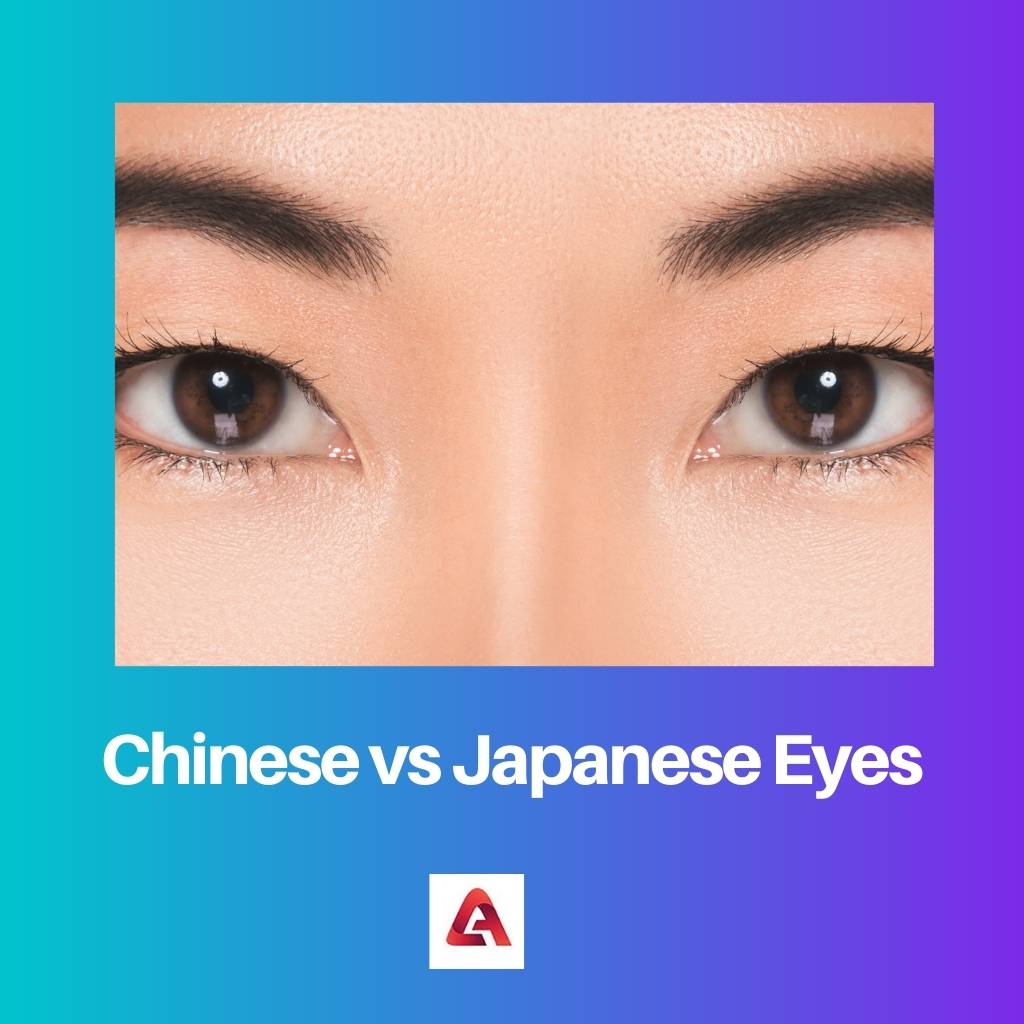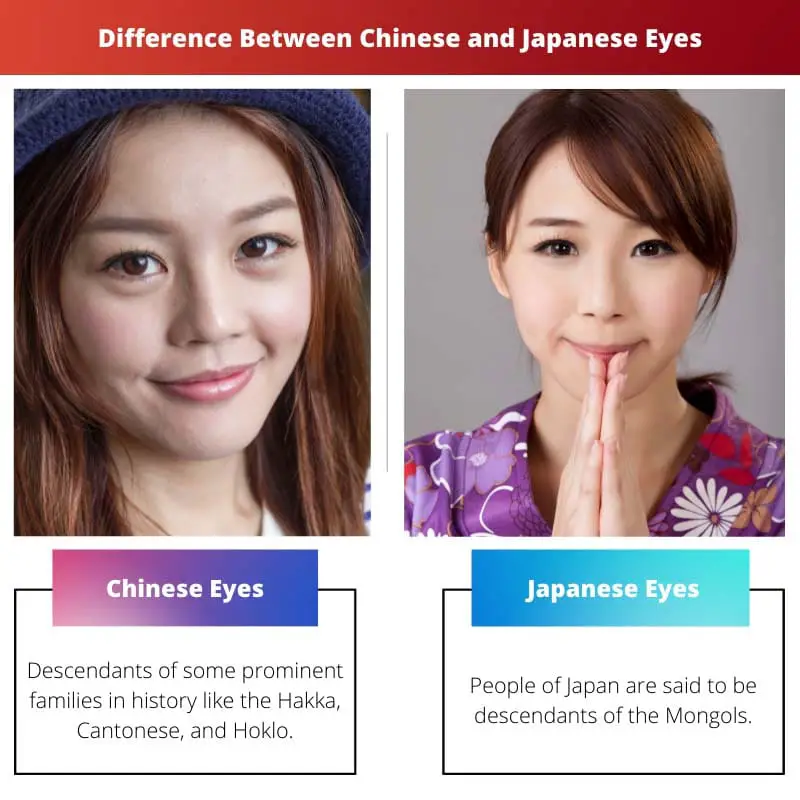Although all humans belong to the same species of animals, there exists variation among every individual and also between groups of individuals based on ethnicity and race.
Our facial structures, like the eyes, nose, face shape, average body height and weight, and skin pigmentation, differ based on our place of origin and natural adaptation.
Key Takeaways
- Chinese and Japanese eyes differ in shape and size, with Chinese eyes being smaller and almond-shaped while Japanese eyes are larger and rounder.
- Another key difference is the presence of the epicanthic fold, which is more common in people of East Asian descent and is more pronounced in Japanese eyes than in Chinese eyes.
- While both Chinese and Japanese people may have eye shapes and sizes variations, these differences should not be used to stereotype or make assumptions about individuals based on their ethnic background.
Chinese vs Japanese Eyes
The difference between Chinese eyes and Japanese eyes lies in their shape and appearance. Chinese eyes are smaller in comparison to Japanese eyes and are angled downwards from the outer edge, while Japanese eyes are comparatively larger and angled upwards towards their brow bone to give a more snatched look.

Chinese eyes are set on a bigger, rounder face and hence are small in size. These are positioned in such a way that they appear to be slanted towards the cheekbone.
The eyes are one of the facial features in the Chinese that are not very prominent. The females tend to have smaller eyes in comparison to the men.
Japanese eyes are set on a long slender face and are wider apart from each other. They are larger (more in females in comparison to men) than the Chinese eyes.
They tend to be bent upwards and thus give the eye a more curved look. Being large on the smaller face is the most prominent feature of the face.
Comparison Table
| Parameters of Comparison | Chinese Eyes | Japanese Eyes |
|---|---|---|
| Ethnicity | Descendants of some prominent families in history like the Hakka, Cantonese, and Hoklo. | People of Japan are said to be descendants of the Mongols. |
| Eye Shape | The eyes are oval to almond-shaped. | The eyes are round to oval in shape. |
| Angle of Eye Placement | The eyes are bent slightly upwards. | The eyes are bent downwards. |
| Eye Size | The eyes are larger than the Chinese eyes. | The eyes are smaller than the Japanese eyes. |
| Based on Gender | The women have larger eyes in comparison to the men. | The women have smaller eyes in comparison to the men. |
| Prominence | It is the most prominent feature on the Japanese face. | It is not the most prominent facial feature. |
| Use of Eye | The eyes are most used in the facial expression of a frown. | The eye is most used in the facial expression of a smile. |
| Eyelids | They have a single large double lid on their bigger eyes. | Have a smaller double lid or monolid on their smaller eyes. |
What are Chinese Eyes?
It is a characteristic of the people of China. The Chinese are said to be the descendants of the Mongols, due to which they inherit the characteristic Mongolian facial features.
The Chinese have a round face. Their bone structure and genetic composition result in the formation of closely set smaller eyes on their flat, round faces.
Subsequently, owing to the large face size, the eyes look small and are not very prominent on the face. The eyes are even smaller in females.
During a smile or a laugh, the eyes are constructed to make them look even smaller. Hence the eyes take part in facial expressions.
The Chinese eyes are angled in such a way that it points towards the cheekbones, further enhancing the round facial features and giving the cheeks a fuller view.
Upon further observation, it is seen that area of most focus in the Chinese eyes is the area underneath the eye. They have prominent under eyes with a naturally large eye bag.
The Chinese have double-edged double eyelids protecting the eye from dust, dirt, and other external substances. The eyelashes are also smaller and less curved.
Some of the best examples of typical Chinese eye structure are Jackie Chan, Bruce Lee, Gong Li, Jack Ma, etc.

What are Japanese Eyes?
It is a characteristic of the people of Japan. The Japanese ethnicity traces its ancestors back to some prominent Asian families like the Holko, Hakka, and Cantonese.
Their facial features are an amalgam of these family characteristics. The Japanese have a longer, narrower face. The shape of the face differs among people; however, it is not completely round like that of the Chinese.
Their bone structure allows the eyes to be widely spaced on their larger faces. Subsequently, the eyes being widely spaces appear to be larger on their narrow face and serve as the first feature to be noted in them.
Smiling has no direct effect on the eye, but frowning is associated with the eye during which the eye is squinted.
The Japanese eyes are angled in such a way that it points towards the brow bone. This makes a face look less round and more narrow.
Upon closer observation, it is seen that the area of most focus in the Japanese eye is the area between the Eye and eyebrows. This space is larger in the Japanese.
The Japanese have single-edged double or single eyelids protecting the eye effectively from dust, dirt, and other external substances. The eyelashes tend to be longer and curved.
Some of the best examples of typical Japanese eye structures are Haruki Murakami, Akihito, Yoko Ono, etc.

Main Differences Between Chinese and Japanese Eyes
- Chinese eyes are smaller in comparison to Japanese eyes.
- Chinese eyes are downward pointing while Japanese eyes are upward-pointing on their outer edges, making the former look narrower than the latter, which appears wide in the middle.
- Chinese eyes are not the most prominent feature of their face, while Japanese eyes are the most notable feature on their face.
- Chinese eyes are shielded by double eyelids, whilst Japanese people may or may not have double eyelids. Monolids are present in Japanese eyes.
- Chinese have a smaller space between the eyebrow and eye, while the Japanese have more space in the same area, making the entire region look bigger.


The distinctions between Chinese and Japanese eyes are clearly articulated, providing a deeper understanding of these differences.
Agreed, the descriptions offer valuable insights into the diversity of human facial characteristics.
The explanations of Chinese and Japanese eye characteristics are detailed and thought-provoking.
I appreciate the attention to detail in describing these physical features and their cultural significance.
The analysis of Chinese and Japanese eyes highlights the importance of acknowledging and understanding physical variations among different ethnic groups.
Agreed, these observations contribute to a more comprehensive understanding of the complexities of human genetics and physical traits.
Absolutely, this offers a valuable perspective on the diversity of human features across different cultures.
The discussion of Chinese and Japanese eyes offers a nuanced examination of these physical variations based on ethnicity and history.
Absolutely, the historical and cultural context of these differences is crucial to consider.
The comparison between Chinese and Japanese eyes is a valuable exploration of the diversity within human populations.
I completely agree, it’s important to recognize and appreciate these distinctions.
The genetic and historical context provided for Chinese and Japanese eyes is quite enlightening.
The analysis of Chinese and Japanese eyes, including the structural and genetic factors, is a valuable contribution to our understanding of these differences.
I agree, it’s important to consider the genetic and historical influences on physical characteristics.
Absolutely, these insights shed light on the complexities of human diversity.
This is a fascinating analysis of the differences between Chinese and Japanese eyes. It’s important to understand these distinctions without using them to reinforce stereotypes.
Absolutely, these observations should be made in a spirit of cultural understanding and appreciation.
I completely agree. It’s crucial to approach these differences with sensitivity and respect.
The descriptions of Chinese and Japanese eyes provide an insightful exploration of the unique characteristics present in different ethnicities.
I completely agree, these descriptions offer a valuable perspective on the diversity of human facial features.
The comparison table is very informative and provides a clear overview of the differences between Chinese and Japanese eyes.
Yes, it’s a concise way to illustrate the nuances of these physical distinctions.
I appreciate the detailed breakdown of specific features and characteristics.